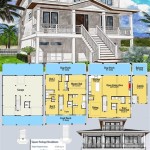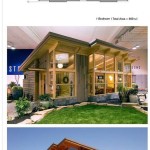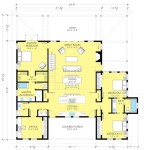Low Country House Plans with Wrap Around Porch: A Guide to Timeless Southern Living
Low Country house plans, often characterized by their expansive wrap-around porches, evoke a sense of Southern hospitality and relaxed living. These homes are not merely architectural structures; they represent a lifestyle deeply rooted in the history and climate of the coastal regions of the American South. The wrap-around porch, in particular, plays a central role in the design, acting as an outdoor extension of the living space and a buffer against the elements.
The architectural style draws inspiration from a variety of sources, including Colonial, Victorian, and Caribbean influences, all adapted to the specific needs and conditions of the Low Country environment. Common features include raised foundations, large windows, light and airy interiors, and, of course, the defining wrap-around porch. These elements work together to create homes that are both aesthetically pleasing and functionally adapted to the warm, humid climate.
Understanding the key elements of Low Country house plans with wrap-around porches is essential for anyone considering building or renovating a home in this style. From the structural considerations to the design details, each aspect contributes to the overall character and functionality of the dwelling.
Understanding the Appeal of the Wrap Around Porch
The wrap-around porch is more than just a decorative feature; it is a functional element that significantly enhances the livability of a Low Country home. Its primary function is to provide shaded outdoor space, protecting residents from the intense sun and heat that are characteristic of the region. The porch also serves as a transition zone between the interior and exterior, blurring the lines between indoor and outdoor living.
Historically, wrap-around porches were essential for ventilation. They allowed breezes to circulate around the house, helping to keep the interior cool and comfortable. In the days before air conditioning, this passive cooling strategy was crucial for maintaining a pleasant living environment. Even today, with the availability of modern climate control systems, the natural ventilation provided by a wrap-around porch remains a valuable asset.
The social aspect of the wrap-around porch should not be overlooked. It provides a welcoming space for socializing with neighbors, relaxing with family, or simply enjoying the surrounding scenery. The porch naturally encourages interaction and fosters a sense of community. It is a place where stories are shared, memories are made, and the pace of life slows down.
From an aesthetic perspective, the wrap-around porch adds a distinctive architectural element to the home. It enhances the curb appeal, creating a sense of grandeur and elegance. The porch also provides an opportunity to showcase decorative elements, such as porch swings, rocking chairs, and potted plants, further contributing to the overall charm and character of the home.
Essential Design Elements of Low Country House Plans
Several key design elements contribute to the distinctive character of Low Country house plans. These elements are not merely decorative; they are carefully considered and integrated to create homes that are both beautiful and functional.
Raised Foundations: Raised foundations are a common feature in Low Country architecture, primarily due to the region's susceptibility to flooding. Raising the house above ground level protects it from potential water damage and helps to improve ventilation beneath the house. This also adds to the visual appeal by giving the house a commanding presence.
Large Windows and Doors: Large windows and doors are another essential element of Low Country homes. These openings allow for ample natural light to enter the interior, creating a bright and airy atmosphere. They also provide unobstructed views of the surrounding landscape, connecting the interior to the outdoors. Often, these windows are designed to allow for cross-ventilation, maximizing airflow throughout the house.
Light-Colored Exteriors: Light colors, such as white, cream, and pale shades of gray or blue, are commonly used for the exteriors of Low Country homes. These colors reflect sunlight, helping to keep the house cool. They also contribute to the overall aesthetic of the home, creating a sense of lightness and airiness.
Durable Materials: The materials used in the construction of Low Country homes are typically chosen for their durability and ability to withstand the region's humid climate. Wood, brick, and stucco are common choices. Particular attention is given to selecting materials that are resistant to moisture, insects, and other environmental factors.
Gabled Roofs: Gabled roofs, often with steep pitches, are a common feature of Low Country house plans. These roofs are effective at shedding water and snow, protecting the house from the elements. They also provide ample attic space, which can be used for storage or additional living space.
Practical Considerations for Building a Low Country Home
Building a Low Country home requires careful planning and consideration of several practical factors. These factors are particularly important given the unique environmental conditions of the region.
Site Selection: Selecting the right site is crucial for the success of any building project, but it is especially important in the Low Country. Factors to consider include the elevation of the site, the proximity to water, and the potential for flooding. It is also important to consider the orientation of the site, ensuring that the house is positioned to take advantage of natural light and breezes.
Flood Protection: Given the region's susceptibility to flooding, it is essential to incorporate flood protection measures into the design and construction of the home. This may include raising the foundation, using flood-resistant materials, and installing drainage systems.
HVAC Systems: Efficient heating, ventilation, and air conditioning (HVAC) systems are crucial for maintaining a comfortable living environment in the Low Country's hot and humid climate. Choosing an appropriate system depends on the size of the house, the insulation levels, and the orientation of the building.
Pest Control: The Low Country is home to a variety of pests, including termites, mosquitoes, and other insects. Implementing effective pest control measures is essential for protecting the house from damage and ensuring the health and safety of the occupants. This may include regular inspections, preventative treatments, and the use of pest-resistant materials.
Local Building Codes: Familiarizing oneself with local building codes and regulations is essential for ensuring that the construction project complies with all applicable requirements. These codes may cover a wide range of issues, including flood protection, energy efficiency, and accessibility.
Working with Experienced Professionals: Building a Low Country home is a complex undertaking that requires the expertise of experienced professionals. Working with architects, builders, and other contractors who are familiar with the region's unique challenges is essential for ensuring the success of the project. These professionals can provide valuable guidance and support throughout the design and construction process.
Proper Insulation: Insulation is key to maintaining a comfortable indoor temperature and reducing energy consumption. Proper insulation in the walls, roof, and floors helps to keep the house cool in the summer and warm in the winter. Different insulation materials have varying R-values (a measure of thermal resistance), so selecting the appropriate materials for the climate is important. Consider spray foam, fiberglass batts, or cellulose insulation, depending on the specific needs and budget.
Window Selection: Windows contribute significantly to energy efficiency and aesthetics. Low-E (low-emissivity) windows are designed to reduce heat transfer, keeping the house cooler in the summer and warmer in the winter. Double-paned or triple-paned windows offer even greater insulation. The frame material also matters; vinyl or fiberglass frames provide better insulation than aluminum. Selecting windows that complement the architectural style of the Low Country home is crucial for maintaining its charm.
Landscaping Considerations: Landscaping plays a vital role in both the aesthetics and functionality of a Low Country home. Native plants are well-suited to the local climate and require less maintenance than non-native species. Trees can provide shade, helping to keep the house cool, while shrubs and ground cover can help to prevent soil erosion. Consider incorporating elements like palmetto trees, azaleas, and Spanish moss to enhance the Southern charm of the landscape.
Outdoor Living Spaces: In addition to the wrap-around porch, consider incorporating other outdoor living spaces into the design of the home. Patios, decks, and outdoor kitchens can extend the living area and provide additional opportunities for relaxation and entertainment. Ensure that these spaces are integrated seamlessly with the surrounding landscape and designed to complement the architectural style of the house.
Low Country house plans with wrap-around porches offer a timeless appeal and a comfortable, relaxed lifestyle. By understanding the key design elements, practical considerations, and the importance of the wrap-around porch, individuals can create homes that are both beautiful and functional, perfectly suited to the unique environment of the coastal South.
:max_bytes(150000):strip_icc()/tideland-haven_0-67e696598afc46328367d3653cfd9724.jpg?strip=all)
13 House Plans With Wrap Around Porches

Lowcountry Style House Plan With Full Wrap Around Porch

Plan 32585wp Southern Sweetheart With Wraparound Farmhouse Style House Plans

Low Country Farmhouse Plan With Wrap Around Porch

Country House Plan 3 Bedrms 2 Baths 1472 Sq Ft 153 1899

Low Country House Plans Floor

New Southern House Plans Blog Builderhouseplans Com

Beautiful Small Country House Plans With Porches Houseplans Blog Com

Low Country Architecture Beach House Plans From Home Designs

Southern Living Dreamy House Plans With Front Porches Blog Dreamhomesource Com
Related Posts








